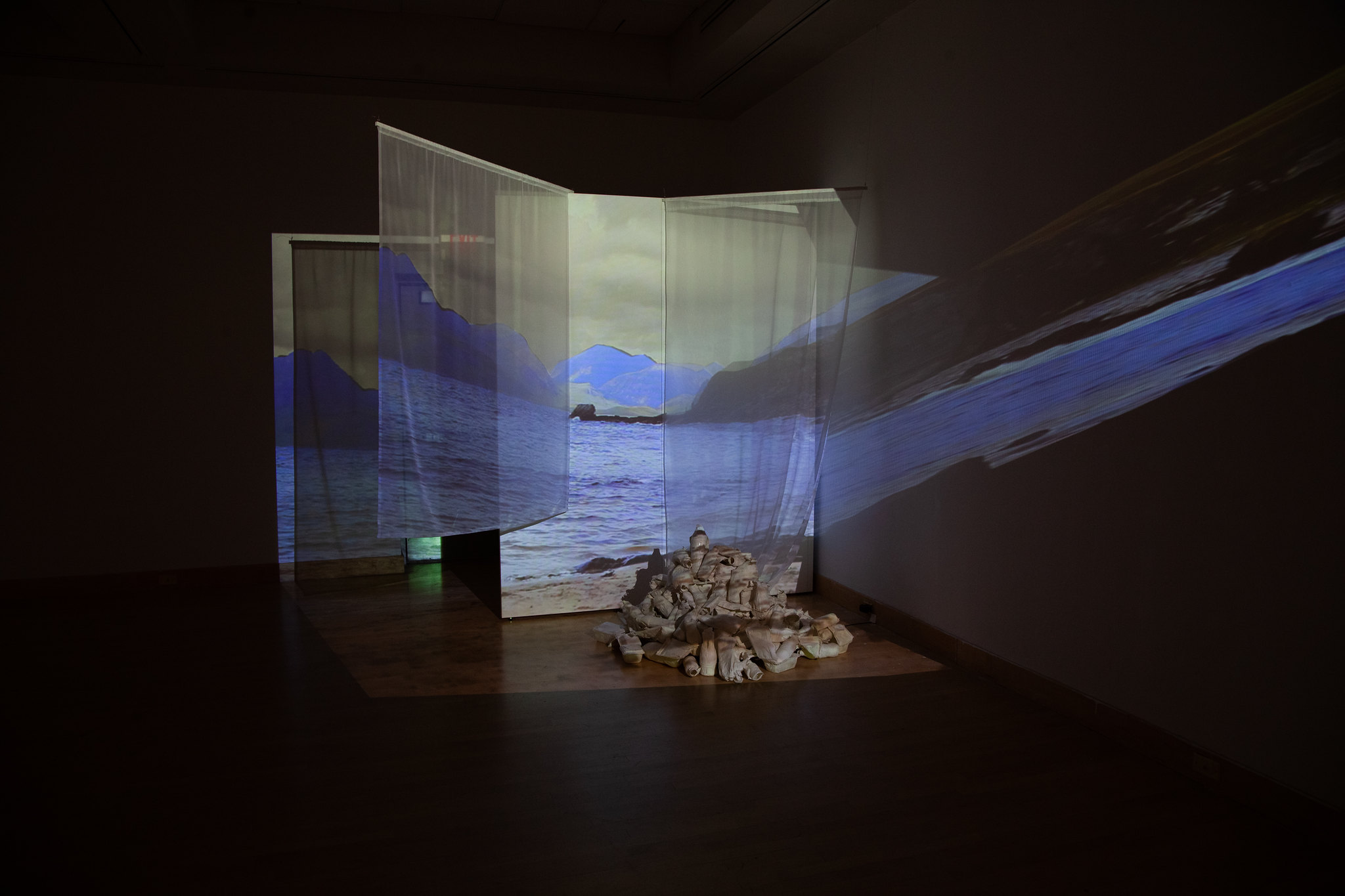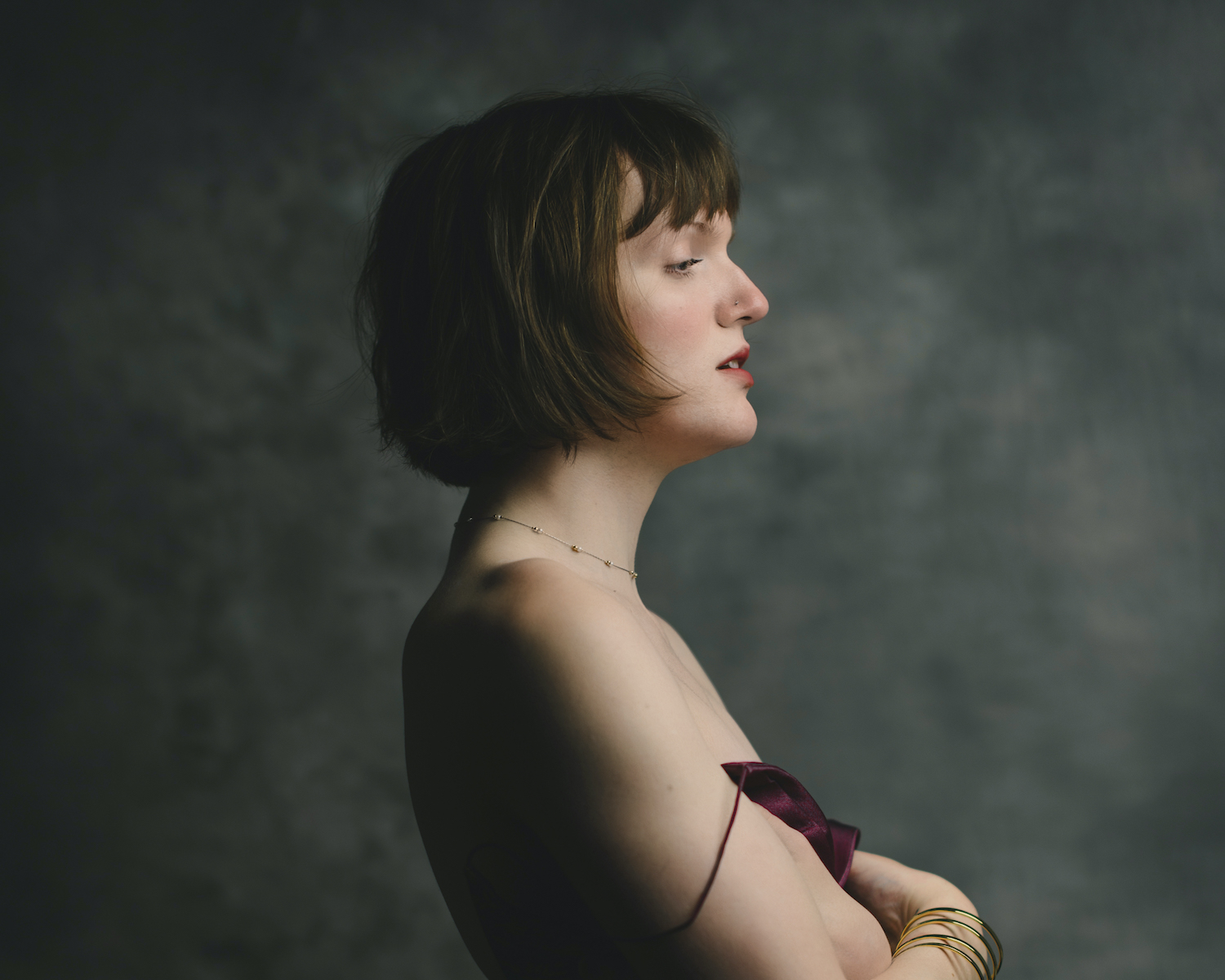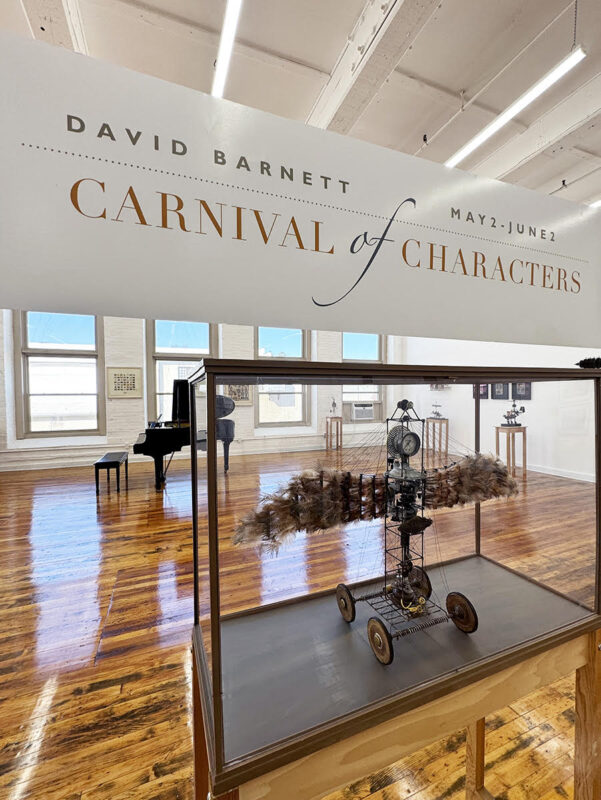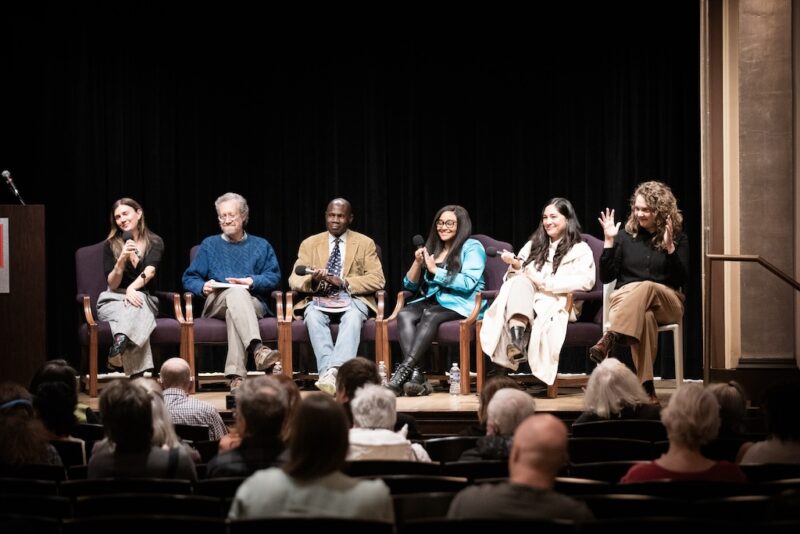It’s hard to believe Untitled Art Fair started in 2012, because the beachfront fair simultaneously feels young and new, but also institutional and grand. In many mental calendars, the curated fair’s opening marks the unofficial annual kick-off of Miami Art Week, and most art professionals will tell you it’s the best of the bunch.
This year, I found myself surprised by a few things. The fair is the most aesthetically heterogeneous I’ve ever seen it—in the past Untitled very much had a “brand” of surprisingly tasteful day-glo work, abstraction and process-based works, and a very Latin American focus (last year I noted that my boyfriend and I realized that we basically only spoke Spanish at the opening!). This year, there are really only a few booths that look like what I have come to expect from this fair—although the wave of figuration that was noticeable last year is still going strong, especially in the representation of Black bodies.
I asked fair director and curator Omar López-Chahoud for his insights on the above shifts I noticed. He explained the fair’s more diverse aesthetic as a reflection of its increasing multiplicity. “We have made an effort to not be so specific, to have different voices. One of those reasons was to create space for galleries from places we had never worked with. So even though there is a global consensus and organization of ideas, the sensibilities in some places are different,” he says. “It makes for a fair that’s much more diverse and dynamic than in the past. There’s a lot of process- and material-based work. We have a lot of artists working with fabric, like Pinto Contemporary’s Filipino tapestries.”
And while the fair retains “a strong Latin American presence this year, we’ve also made an effort the past two years to bring more artists from continental Africa… to pay attention to ‘The Greater South,’” as López-Chahoud phrases it. And conversely, the fair worked with guest curator Jordan Stein to help Untitled connect on a local level rather than just internationally. The curatorial team commissioned a variety of environmentally minded projects from local artists, which are scattered both inside and outside the tent.
“This year has been a big focus on the Everglades—it’s about all the ecological issues we’re dealing with right now. We’re really paying attention to where we are,” López-Chahoud explains. “We’re making an effort to work with the local environment and incorporate local culture. But at the same time it’s important to not forget that this is the most international fair we’ve done. This year we have participation from 28 counties—we have one of the few galleries from Ethiopia dealing with contemporary art.”
Taking another lap around the fair, I found myself a little more uneasy about the disconnect between all the good artistic/curatorial intent and the logistical realities of art fairs. Which is to say, the whole art fair model is inherently unsustainable in environmental terms—it feels a little silly to applaud a booth or two given over to potted native plants as a “green” gesture in a massive tent full of objects and people that have been shipped thousands of miles to be lit and air conditioned by a giant array of generators just meters away.
I’m hoping these are issues we start to discuss in the year to come, because rising to this challenge could yield some really cool, creative solutions from artists. What are less carbon-intensive strategies for making and displaying art? Travel? Should we be adaptively reusing any of the myriad dead malls or surplus vacant retail spaces around South Florida (like the Satellite Art Show, Mana Contemporary, or Spinello Projects’ FREE! fair has done so well) instead of literally air conditioning the great outdoors? Or can we at least fucking switch to solar?

I really appreciated the lack of greenwashing in a commissioned project by The Department of Reflection (local artist Misael Soto’s public art platform) installed in between Ocean Drive and the entrance to the tent. The installation comprises two reflecting pools made of sandbags, a material familiar to anyone who’s lived in a flood zone. At certain times, a pianist plays the keyboard between them, only to be drowned out by seawater pumps furiously filling the pools. They’re a reference to region’s storm surge defense systems, which seem a little absurd and futile in the face of ever-rising sea levels.
The irony of the whole assemblage is compounded by the fact that it’s all petroleum-powered engines and the audience ends up having to breath acrid exhaust. Something about the theatrical dystopian absurdity of it all made me think back to Mirium Simun’s brilliant public work GhostFood presented by The Contemporary in Baltimore a few years ago, in which she had a futuristic food truck offering Silicon-Valley-startup-style replacements for endangered food products.

This year the fair partnered with LA gallery Shulamit Nazarian on the VIP lounge. The highlight of this were giant sofas that artist Wendy White made out of pants. I met White and excitedly showed her the article I wrote last year in which I declared “pants are the new plants!” at Miami art fairs. (Seriously, why have pants become a medium!? I still haven’t figured this out, but I love it).
Anyway, I think the VIP lounge is also a great example of artists doing something fun and aesthetic that’s also eco-conscious (the production of cotton and especially blue jeans is an environmental disaster so we all SHOULD be up-cycling our pants into upholstery or paintings or tapestries!) in stark contrast to art-fair business as usual. After walking around the fair for hours being lectured about the coming climate apocalypse I was starving, but even the salads for sale in the lounge had meat in them. So I guess the thinking is VIPs like sustainability when it’s about new things to consume (new plants! old pants!) but not when it’s about sacrificing some super carbon-intensive luxury like bacon or climate control.
Some other highlights:
 Edel Assanti (London) is showing Orin Pinhassi’s sand-textured sculptures that reference landscape, architecture, furniture, modernism, and the body. They’re a nice mix of being abstract and evocative of referents with often contradictory associations—shall we call this “an uncomfortable ergonomics” perhaps? Mixed-media wall-hanging work by Gordon Cheung (L) and Sheida Soleimani also plays with the figure/landscape. Collectively the booth has a sort of future-ruin, low-tech cyborg vibe.
Edel Assanti (London) is showing Orin Pinhassi’s sand-textured sculptures that reference landscape, architecture, furniture, modernism, and the body. They’re a nice mix of being abstract and evocative of referents with often contradictory associations—shall we call this “an uncomfortable ergonomics” perhaps? Mixed-media wall-hanging work by Gordon Cheung (L) and Sheida Soleimani also plays with the figure/landscape. Collectively the booth has a sort of future-ruin, low-tech cyborg vibe.
 LA’s Nino Mier Gallery has one of those gimmicky booths that I would usually hate but this one actually kinda works due to Jana Schröder’s soul-piercing politician gaze. It invites viewer participation by positioning Schröder and Andreas Breunig as opponents in an absurd “viewers’ choice” kinda competition, where we the public cast votes on who is the better artist. The statement describes it as a “competition against relativism.” I didn’t cast a vote but I think I would vote for Schröder just because she looks like she’d beat me up at some hotel party later this week if I had voted against her.
LA’s Nino Mier Gallery has one of those gimmicky booths that I would usually hate but this one actually kinda works due to Jana Schröder’s soul-piercing politician gaze. It invites viewer participation by positioning Schröder and Andreas Breunig as opponents in an absurd “viewers’ choice” kinda competition, where we the public cast votes on who is the better artist. The statement describes it as a “competition against relativism.” I didn’t cast a vote but I think I would vote for Schröder just because she looks like she’d beat me up at some hotel party later this week if I had voted against her.
LatchKey Gallery shipped all of Damien Davis’s kinda Afrofuturistic plexiglass assemblages in this artist-designed CNC-milled crate that become furniture for the booth, a reference to Henry Box Brown, who escaped slavery by shipping himself in a crate from Richmond to Philadelphia. I think it’s a smart way of incorporating pesky logistic considerations into booth design.
I asked Davis about his imagery, which feels mundane-made-glamourous, and he explained it came from thinking about “the myriad ways people, places, and things get labelled as ‘Black’ but also how the Black body becomes more precarious through the acquisition of wealth or power… thinking about the massacre of Black Wall Street and how that history has been forgotten and is only now entering the mainstream discourse.”
I had just been thinking of those Alex & Chloë acrylic charm necklaces half of the people attending art fairs probably did cocaine off of in the mid-2000s and how you never see those around anymore even though they’re a material that won’t biodegrade for thousands of years, and that future archeologists will find little shiny portraits of Kate Moss in the underwater ruins of Brooklyn.
And so this material makes sense for Davis and a future archeology of Black stories that are often erased, such as the Tulsa massacre—which we never hear about even though bombs were literally dropped from planes during a race war on US soil in the 20th century. It took an HBO show about superheroes a century later to get people to pay attention to this.
 Bel Fullana at New York’s Freight+Volume: Everything in this booth is amazing, but these sexy/unsexy paintings are my favorite. I don’t think I realized this in Untitled’s glorious lighting, but now that I am seeing a photo of the painting on the left on my laptop screen I’m wondering if the figure is shooting yellow diarrhea either at the viewer (take THAT, male gaze!) or onto her own face?
Bel Fullana at New York’s Freight+Volume: Everything in this booth is amazing, but these sexy/unsexy paintings are my favorite. I don’t think I realized this in Untitled’s glorious lighting, but now that I am seeing a photo of the painting on the left on my laptop screen I’m wondering if the figure is shooting yellow diarrhea either at the viewer (take THAT, male gaze!) or onto her own face?
 Mark Whalen Eric Parker (pyramid) and Adam Berris at Over the Influence (Los Angeles and Hong Kong). I don’t have much to say about this work other than the fact that it’s fun and looks like what nearly every booth at Untitled used to look like.
Mark Whalen Eric Parker (pyramid) and Adam Berris at Over the Influence (Los Angeles and Hong Kong). I don’t have much to say about this work other than the fact that it’s fun and looks like what nearly every booth at Untitled used to look like.
 Special Project: Coral Projects, Everglades Art Lab presented by Benrubi Gallery, a collaboration between Vanessa Albury, Rachel Frank, Thale Fastvold, Tanja Thorjussen, with Reverend Houston Cypress of Love the Everglades.
Special Project: Coral Projects, Everglades Art Lab presented by Benrubi Gallery, a collaboration between Vanessa Albury, Rachel Frank, Thale Fastvold, Tanja Thorjussen, with Reverend Houston Cypress of Love the Everglades.
These artists all made work in and about the Everglades, and here they’re showing mainly video documentation, an installation of local plants, and some small photos and ceramics. Apparently a highlight for the artists in their swampy project was an ibis bird interacting with the sculptures! Next, they’re planning an underwater exhibition in Jamaica.
When I talked to Vanessa Albury she told me, “We love art critics! Everyone comes to you with an opportunity to grow, to realize what you did wrong and learn from it.” What a nice thing to hear!
 Los Angeles New Image Art (L-R): Ammon Rost, Aaron Jupin, Patricia Renée Thomas, Umar Rashid, Emma Kohlmann
Los Angeles New Image Art (L-R): Ammon Rost, Aaron Jupin, Patricia Renée Thomas, Umar Rashid, Emma Kohlmann
Every painter New Image Art is showing in very-close quarters is totally different but they all look great together. Apparently they’re going to be rotating these paintings around, and I can’t wait to see what else they have hidden away and what sells. I would buy almost everything in the booth. I think they did a great job cramming a lot of work on their walls without it feeling overhung, and I am still trying to figure out how they pulled it off.
I know fair director López-Chahoud goes around and makes sure booths don’t look chaotic, and that’s part of why this fair is always so photogenic.
 Emma Kohlmann
Emma Kohlmann
 Bogota’s SRG Galería: Argentinian artist Luciano Denver’s recent series of fantasy Havana modernist cityscapes, which feel presented super dryly—neither fetishizing brutalism nor commenting on the unfulfilled promise of Communist utopianism. They seem documentarian but are actually digital collages of imaginary street scenes, such as the nonexistent beachside “Monumento al Camello,” an invented monument to the city’s public transportation system incongruously sited in a parking lot.
Bogota’s SRG Galería: Argentinian artist Luciano Denver’s recent series of fantasy Havana modernist cityscapes, which feel presented super dryly—neither fetishizing brutalism nor commenting on the unfulfilled promise of Communist utopianism. They seem documentarian but are actually digital collages of imaginary street scenes, such as the nonexistent beachside “Monumento al Camello,” an invented monument to the city’s public transportation system incongruously sited in a parking lot.
 Norwegian painter Audun Alvestad at Berlin gallery Kristin Hjellegjerde. Of all the paintings at Untitled that are painted in this style (what should we call this enduring movement of fleshy, almost cartoon-like figuration that’s everywhere these days?), these are probably the best.
Norwegian painter Audun Alvestad at Berlin gallery Kristin Hjellegjerde. Of all the paintings at Untitled that are painted in this style (what should we call this enduring movement of fleshy, almost cartoon-like figuration that’s everywhere these days?), these are probably the best.
 Wendy White at Shulamit Nazarian Los Angeles: More Wendy White pants paintings! I think I love these even more than the couches.
Wendy White at Shulamit Nazarian Los Angeles: More Wendy White pants paintings! I think I love these even more than the couches.
 I took this photo of San Francisco-based Gallery Wendi Norris because these booth feels like a synecdoche of several things I have been thinking about Untitled. One, there are so many California galleries this year. People I spoke with attributed that to the launch of Untitled’s San Francisco edition and the brand’s success on the West Coast. But also this Julio César Morales sums up a lot of what I love about Untitled—the ability to make work that balances trendy, minimal aesthetics with a geopolitical sensibility. I can’t think of a more “Untitled-ready” art object than a neon sign sketching the fraught border between the United States and Latin America.
I took this photo of San Francisco-based Gallery Wendi Norris because these booth feels like a synecdoche of several things I have been thinking about Untitled. One, there are so many California galleries this year. People I spoke with attributed that to the launch of Untitled’s San Francisco edition and the brand’s success on the West Coast. But also this Julio César Morales sums up a lot of what I love about Untitled—the ability to make work that balances trendy, minimal aesthetics with a geopolitical sensibility. I can’t think of a more “Untitled-ready” art object than a neon sign sketching the fraught border between the United States and Latin America.
 “The tragic thing about this dinner party is that we’re all too late,” Xavier Cortada told us as we sat down at his commissioned public performance back outside. He travelled to the North Pole for an artist residency on an ice breaker, which apparently travelled at record time due to the thinness of the ice caps. As one of many projects, he brought back actual ice from the cap around the North Pole to share with us: “I think of this as a ‘North Pole Communion’—if the North Pole is in you, you are preserving it, because it is part of you.”
“The tragic thing about this dinner party is that we’re all too late,” Xavier Cortada told us as we sat down at his commissioned public performance back outside. He travelled to the North Pole for an artist residency on an ice breaker, which apparently travelled at record time due to the thinness of the ice caps. As one of many projects, he brought back actual ice from the cap around the North Pole to share with us: “I think of this as a ‘North Pole Communion’—if the North Pole is in you, you are preserving it, because it is part of you.”
I’m a little concerned that Cortada might be inadvertently serving frozen prehistoric microbes that predate contemporary human immunity, but I ate some anyway. And hey, if you wanted to stop global warming, spreading a planetary pandemic at an international art fair might be a good way to thin the herd?
Cortada gestured to a series of washy blue landscapes he painted on the trip: “When the third phase of ice melting happens, these landscapes I painted in the Arctic, all bets are off. It’s goodbye Florida. Goodbye to the only place I’ve ever called home. We know this is happening and we could stop it but we don’t… We’re arrogant… But these stakes are so high for me.”
Leaving Cortada’s performance, I walked along the beach to Scope (which makes a jarring counterpoint to Untitled and offers the best evidence as to why art fairs need strong curatorial leadership). Walking there, I passed the whole back of the Untitled tent, where rows of air conditioners and generators churned. I immediately felt guilty again, and turning the corner, there was a tanker delivering more gasoline to power the fair. I love the worldwide exchange of ideas and culture and art that happens at these things. But if even the forum itself isn’t heeding the ideas it’s selling, I don’t have a lot of optimism that this beach will be here much longer.

Photos by the author








